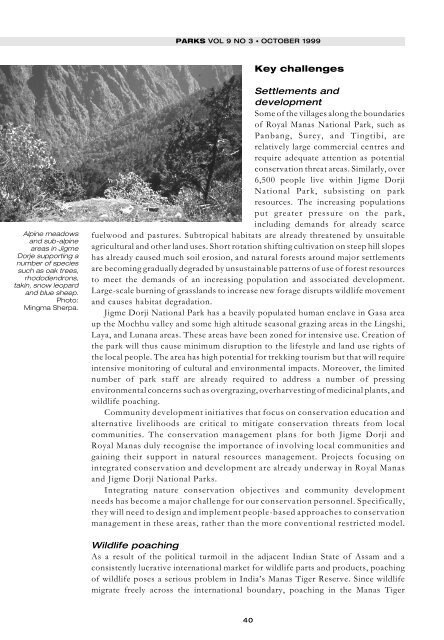Parks - IUCN
Parks - IUCN
Parks - IUCN
Create successful ePaper yourself
Turn your PDF publications into a flip-book with our unique Google optimized e-Paper software.
Alpine meadows<br />
and sub-alpine<br />
areas in Jigme<br />
Dorje supporting a<br />
number of species<br />
such as oak trees,<br />
rhododendrons,<br />
takin, snow leopard<br />
and blue sheep.<br />
Photo:<br />
Mingma Sherpa.<br />
PARKS VOL 9 NO 3 • OCTOBER 1999<br />
40<br />
Key challenges<br />
Settlements and<br />
development<br />
Some of the villages along the boundaries<br />
of Royal Manas National Park, such as<br />
Panbang, Surey, and Tingtibi, are<br />
relatively large commercial centres and<br />
require adequate attention as potential<br />
conservation threat areas. Similarly, over<br />
6,500 people live within Jigme Dorji<br />
National Park, subsisting on park<br />
resources. The increasing populations<br />
put greater pressure on the park,<br />
including demands for already scarce<br />
fuelwood and pastures. Subtropical habitats are already threatened by unsuitable<br />
agricultural and other land uses. Short rotation shifting cultivation on steep hill slopes<br />
has already caused much soil erosion, and natural forests around major settlements<br />
are becoming gradually degraded by unsustainable patterns of use of forest resources<br />
to meet the demands of an increasing population and associated development.<br />
Large-scale burning of grasslands to increase new forage disrupts wildlife movement<br />
and causes habitat degradation.<br />
Jigme Dorji National Park has a heavily populated human enclave in Gasa area<br />
up the Mochhu valley and some high altitude seasonal grazing areas in the Lingshi,<br />
Laya, and Lunana areas. These areas have been zoned for intensive use. Creation of<br />
the park will thus cause minimum disruption to the lifestyle and land use rights of<br />
the local people. The area has high potential for trekking tourism but that will require<br />
intensive monitoring of cultural and environmental impacts. Moreover, the limited<br />
number of park staff are already required to address a number of pressing<br />
environmental concerns such as overgrazing, overharvesting of medicinal plants, and<br />
wildlife poaching.<br />
Community development initiatives that focus on conservation education and<br />
alternative livelihoods are critical to mitigate conservation threats from local<br />
communities. The conservation management plans for both Jigme Dorji and<br />
Royal Manas duly recognise the importance of involving local communities and<br />
gaining their support in natural resources management. Projects focusing on<br />
integrated conservation and development are already underway in Royal Manas<br />
and Jigme Dorji National <strong>Parks</strong>.<br />
Integrating nature conservation objectives and community development<br />
needs has become a major challenge for our conservation personnel. Specifically,<br />
they will need to design and implement people-based approaches to conservation<br />
management in these areas, rather than the more conventional restricted model.<br />
Wildlife poaching<br />
As a result of the political turmoil in the adjacent Indian State of Assam and a<br />
consistently lucrative international market for wildlife parts and products, poaching<br />
of wildlife poses a serious problem in India’s Manas Tiger Reserve. Since wildlife<br />
migrate freely across the international boundary, poaching in the Manas Tiger

















